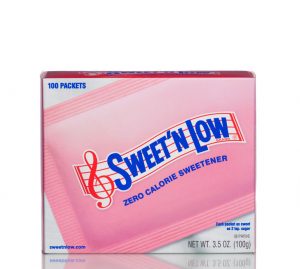
Advertisers have painted a very different picture of saccharin over the past thirty+ years, and the politics behind “sodium saccharide” has left it with a bum rap.
I consider the original saccharin a more natural and healthy alternative because it is not a highly chemical one.
People say that they don’t like its taste, but the secret to using saccharin is not using too much or it will taste bitter.
Saccharin is actually a plant sugar derivative, and in the late 1800s when saccharin was “accidentally” discovered, it was considered an authentic sugar substitute because it was the only known alternative to traditional sugar.
I have always been puzzled at the story told by the manufacturers that saccharin is a tar-based derivative that was discovered in a lab. I am skeptical after talking with WWII vets stationed in India during the war. They told me that they got saccharin from China, and were told that it came from a plant.
So, if saccharin was first created in a lab from tar, are they considering tar as plant based?
Unfortunately, saccharin today is still made in a laboratory and the pink packet is filled with anti-caking agents and emulsifiers. Saccharin is no longer sourced to its origin, but saccharin is still one of the better choices out of the “colorful paper packets.”
Here’s why…
Saccharin’s History
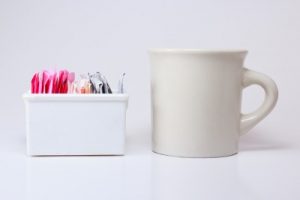
The history of saccharin tells the story of its safety, and shows that it was originally from a plant.
The story that’s been out there since aspartame came on the market is that in 1879, Constantine Fahlberg discovered the sweetness of saccharin by accident.
It’s interesting that aspartame, sucralose, and saccharin were “all discovered by accident.” Just saying.
While working on plant studies in the lab, he spilled some chemicals on his hand. Later while eating dinner, he noticed more sweetness in his bread. He traced the sweetness back to the concoction he spilled in the lab, which he later named saccharin—a spin-off of saccharide (complex sugar).
By 1907, saccharin was being used as a replacement for sugar in foods for diabetics. Since pure saccharin is not metabolized into the bloodstream, it is classified as a noncaloric sweetener.
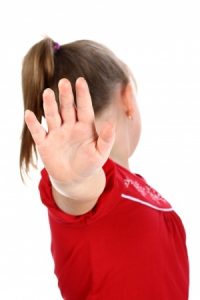
Full Stop
Stop for a second and process this statement: saccharin is not metabolized into your bloodstream.
Aspartame penetrates into your brain.
Sucralose is toxic to your liver, kidneys and bladder.
Acesulfame-K and cyclamate were shown to cause cancer in lab rats.
This confirms that saccharin is not metabolized in your bloodstream and its cancer warning was proven as false, so it is obviously safer for human consumption, especially for diabetics because it won’t spike your blood sugar.
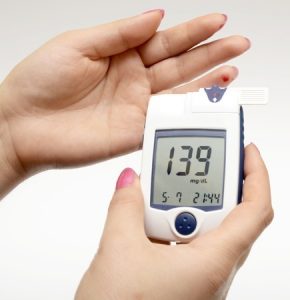
Back To Saccharin’s History
Saccharin was widely used in Europe during World War II because of a sugar shortage, and European countries still use saccharin today as their sweetener of choice.
In the 1960s, saccharin was first used in the “diet soft drink industry” in Coca Cola’s Tab® and Fresca®, but the diet industry never took off.
Why Was Saccharin Labeled A Carcinogen?
According to the research in my books, saccharin was sacrificed in the 1960s to make room for the new, more profitable sweetener, NutraSweet/Equal.
In 1902, Monsanto Chemical Company gained its reputation by manufacturing saccharin, the company’s first product. From 1903 through 1905, their entire saccharin output was shipped to the growing, new soft drink company in Georgia, The Coca-Cola Company®.
So how do you smear a product that was used successfully for so long?

You question it as a carcinogen — out of the blue in 1969. No reputable scientific proof was ever presented, and this was the year NutraSweet applied for their first patent.
Something most people don’t know is the saccharin toxicity study was actually done using a blend of cyclamate and saccharin, and the results were “shown” as linking cyclamate — not saccharin — to bladder cancer in the lab rats.
Researchers fed laboratory mice sweetened water that was equivalent to 800 cans of saccharin/cyclamate every day from birth until death. In ONE test, ONE mouse developed bladder cancer, and the results were then submitted to the FDA requesting a cancer warning be placed on all saccharin products.
Cyclamate was banned in 1970. No further testing was performed on cyclamate.
The Sweetener Wars
Why didn’t the manufacturer of saccharin fight back?
It had everything to do with aspartame.
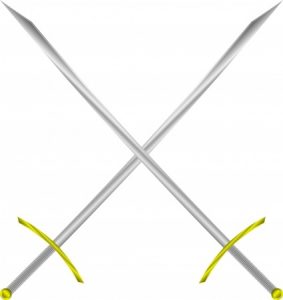
Eight years after the “saccharin/cancer” scheme, G.D. Searle Pharmaceuticals (the original aspartame manufacturer) finally secured FDA approval for NutraSweet in a second patent request.
It then prepared to sell their sweetener business to Monsanto, the original saccharin manufacturer. Soon, NutraSweet and saccharin (its only competitor) would be owned by the same company—Monsanto Chemical Company.
At this time in 1981, the FDA printed the first cancer warnings on the pink saccharin packets – the year NutraSweet came onto the market.
So, saccharin didn’t fight back because both saccharin and aspartame were now owned and marketed by the same company- Monsanto.
If aspartame turned out to be a dud, Monsanto had saccharin waiting on the side-lines.
In 2001, the cancer warning was removed from all saccharin products. Saccharin was deemed safe for human consumption — once again.
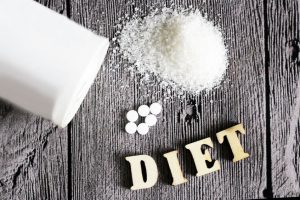
Saccharin — The Oldest Artificial Sweetener
For the most part, saccharin’s chemical make-up is simple — especially in comparison to the manufacturing process of the other chemical sweeteners, such as sucralose (made with chlorine) and aspartame (bound with methanol).
Saccharin has provided the foundation for many low-calorie and sugar-free products around the world. It is still used in tabletop sweeteners, baked goods, jams, chewing gum, canned fruit, candy, dessert toppings and salad dressings.
Saccharin contains only one-eighth of a calorie per teaspoon, and is approximately 300 times sweeter than sugar. Today, saccharin is available in both powdered and liquid forms sold without the cancer warning, and is being reintroduced into food products as safe.
Despite what you’ve been told for decades, it’s fine to choose the pink packet — even if it has a different brand name. (Always read your labels, though, just in case they’ve added unnecessary ingredients.)
If you must use an artificial sweetener on the restaurant tabletops, I recommend saccharin over aspartame or sucralose.
________________
If you want to learn more about the diet sweeteners, contact me at janethull.com. Remember that you are never alone when you are looking for good health!
I look forward to supporting you on your journey to alternative health and wellness.
_____________
Disclaimer: This article is for informational purposes only, and is educational in nature. The FDA may not have evaluated some of the statements. This article is not intended to diagnose, treat, cure, or prevent any disease. Please discuss with your own, qualified health care provider before adding supplements or making any changes to your dietary program.
Before taking vitamins, consult your doctor; pre-existing medical conditions or medications you are taking can affect how your body responds to multivitamins.
You have our permission to reprint this article if you attribute us with a live back-link to this article and the youtube links. https://janethull.com/